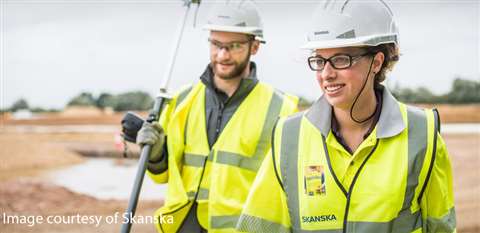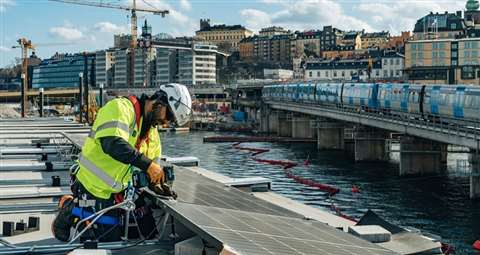How Skanska has protected its profit margin amid inflation
16 March 2023
Inflation and supply chain disruption pose a major risk to construction contractors’ bottom line.
 Image courtesy of Skanska
Image courtesy of Skanska
Unfortunately, the war in Ukraine and the lingering effects of the covid-19 pandemic mean that both inflation and supply chain disruption are exactly what the construction industry has been grappling with.
As more major contractors around the world publish their annual results for the 2022 financial year, it is clear that some have struggled to protect their already slim profit margin amid rising costs.
Others have proven surprisingly resilient (see chart below).
For those who have managed this feat, one term comes up again and again in their annual reports: “Selective bidding”.
Last week, Swedish multinational construction company Skanska published its annual report, detailing a strong performance in 2022, despite the headwinds. As well as boasting an order backlog at a “historic high”, it said it had “managed materials shortages [and] cost escalations well”.
Skanska said that the upheaval resulted in “financial and non-financial consequences for projects”. Those included a decrease in productivity due to the supply chain problems, as well as postponement of new projects. It also warned that potential impacts included increasing costs, decreasing profit and “margin fade”.
Nonetheless, its operating margin in its construction business for the full year held steady at 3.7% (compared to 3.8% the year before).
Chief executive Anders Danielsson put the strong performance in construction down to a “clear focus on selective bidding and commercial management”.
Explaining its approach, Skanska said that it has put profitability ahead of the volume of the contracts it takes on.
Skanska said, “In response to current risks, we have an increased focus on securing contractual protection against inflation, securing prices from suppliers from suppliers before bidding, and ensuring sufficient contingency in bid prices.”
‘Know what you are good at’
Speaking to International Construction, Skanska UK president and CEO Gregor Craig explains that the contractor has a group-wide project scrutiny and approval procedure that is consistent in its format across different regions.
“At the heart of it is knowing what you are good at and sticking to it. That puts you in a really good place to start with,” he explains.
That sounds simple but Skanska has applied a sophisticated, evidence-based approach to that philosophy.
 Skanska is testing a new solution with solar cells on construction sheds as part of a 140m steel bridge it is building in the centre of Stockholm (Image courtesy of Skanska)
Skanska is testing a new solution with solar cells on construction sheds as part of a 140m steel bridge it is building in the centre of Stockholm (Image courtesy of Skanska)
In the UK, Skanska studied 10 years’ worth of projects where it made the right return and where it didn’t. More recently, it re-ran the process over the last three years.
This has allowed it to identify its “sweetspots”. The company can see not just which sectors it performs well in, but which geographical locations it has the appropriate supply chain and resource levels to take on such a project, as well as what type of contracts and what type of customers help it to perform well.
“Once you have these sorts of details, you can draw up a heatmap that tells us, for example, that the core business for us in a particular part of Skanska is commercial offices up to £150m (US180 million) done in a two-stage contracting method,” says Craig.
If a project is of interest but falls outside of those parameters - if it is worth £200m (US$240.5m) rather than £150m, for example - then Skanska considers it worthy of extra scrutiny.
“The business unit president in the country can make the decision up to a certain level and then above that it does to the group leadership team in Sweden. And if it is a really big project it goes to our ‘project review committee’ with the members of the Skanska group board who examine the risks associated with it,” he says.
The contractor reviews its heat map on a regular basis, which means at least annually, to check that the sweetspots of last year remain the same.
Monitoring suppliers’ financial health
The contractor also keeps a close watch on the financial health of its subcontractors and suppliers.
“We have devised a method of quantifying the risk relative to inflation for individual projects. We have a formula for understanding firstly the type of contract and then the procurement strategy associated with it,” says Craig.
“In theory, when you subcontract a proportion of your project then you are passing risk into the supply chain. That is a lower risk than when we are self-performing it all ourselves and the labour and materials costs are all down to us. But laying off a risk into the supply chain is no use unless you have got a really robust supply chain. So you have to satisfy yourself that they are large enough companies that can properly deal with that risk and we have a method of looking at that.”
Looking ahead, Craig sees direct inflationary pressure reducing but cautions that construction companies still need to be careful of underlying risk. That includes supply chain partners who may have taken on risks elsewhere. “You need to be careful for a period of time after the risk has abated,” he says.
Training for scrutiny
Meanwhile, Skanska recognises the ability to scrutinise a project as a skill that its employees should possess. And it trains them for it.
“It’s about not just how to scrutinise but how to be scrutinised,” says Craig.
“We need our teams to be very transparent. We don’t want them just to defend a bid they would really like to do but just tell it like it is.
“Once you know your teams are being transparent, you can get to the crux of any risk very quickly.”
Big contractors’ margins hold steady
Skanska is not alone in managing to maintain margin in the face of the challenges of the past year.
French conglomerate Vinci last month revealed that ebit margin at its Vinci Construction arm was at “its highest level for many years, despite cost inflation”, standing at 3.8%.
It also credited its performance to a “highly selective approach” when taking on new business.
Many of the world’s biggest construction companies, particularly those in Asia, are yet to reveal their annual results for 2022.
For a chart showing the operating margin for 10 of the world’s biggest contractors to have reported so far, see above.
STAY CONNECTED



Receive the information you need when you need it through our world-leading magazines, newsletters and daily briefings.
CONNECT WITH THE TEAM








